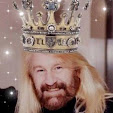My life is filled with thoughts of theatre and film - music and traveling - art and creation. But, my good friends know the dark little secret in the confines of my non-public persona: I'm fascinated and intrigued with the phenomena of serial killers.
These are the people who know my home library is stuffed with books on serials killers and bizarre murder schemes and true crime tales of the people who almost got away it! It's rare when I pick up one of these books that I can stop before reaching the last page!
If I'm going to a film, often my guilty pleasure will be a gruesome tale of a demented mind with serial killing thoughts running through his head. No question, Se7en, with Brad Pitt and Morgan Freeman is one of my all-time favorite movies. (gasp! Even more than a good film noir - though there is much they have in common!)
And, these same people know not to call, text or Facebook me during my
favorite tv show hours each week, because when Criminal Minds or
American Horror Story is on, that's where I'll be!
Always, however, I found the game of Clue fell
a bit flat. I wanted more from the murder mansion’s one-dimensional
floor plan, and really, how were we ever supposed to solve crime
with a cast of suspects crafted into tiny plastic tokens?But it turns out, around the very same time that the iconic American board game was being developed in the 1940s, forensics detectives were being trained for real crime scene investigation in a similar, miniaturized fashion, with the help of a special collection of dollhouses.
Frances Glessner Lee, also known as “the mother of forensic science”
crafted a series of perfectly proportioned dioramas that turned
children’s dollhouses into macabre nightmares– all in the name of
science. Going into far more gory detail than your average Clue game,
Lee’s miniature crime scenes were part of a department of legal
medicine that she established at Harvard University in 1945. The
department was called the Nutshell Studies of Unexplained Death, named
after the principles of forensic investigation, “to convict the guilty,
clear the innocent, and find the truth in a nutshell.”
At a time when forensic science was still in its infancy, Lee was
hosting week-long seminars and lectures in homicide investigation for
law enforcement’s finest, inviting detectives, prosecutors and
investigators from around the world to study 20 intricately designed
dollhouse dioramas based on true crime scenes and autopsies she had
visited.
Armed with magnifying glasses and flashlights, students were given 90
minutes to study each scene and tasked with collecting all the relevant
evidence.
The dollhouses were filled with clues and mousetraps, and the doll
corpses extremely detailed, often depicted with discoloration or
bloating, often observed by Lee during real-life autopsies.
An apparent suicide comes into question when one of the victim’s shoes
can be discovered around the corner of the diaroma. Another victim shows
tiny bite marks on her neck and chest.
Far removed from a little girl’s make-believe world, dolls commonly
represented real-life victims of domestic violence and prostitution– on a
1:12 scale.
Frances Glessner Lee was not your average forensic science enthusiast.
Daughter of a wealthy Chicago industrialist, she was educated at home,
prohibited from attending college, while her brother went off to
Harvard. When he brought home a classmate who studied medicine,
specialising in death investigation at Harvard, it sparked Lee’s early
curiosity in forensic pathology.
Dissuaded from pursuing her new interest, she spent most of her life
playing the role of a Chicagoan socialite, marrying and divorcing a
wealthy lawyer, before inheriting the family fortune at the age of 52
following the death of her brother. With her new found freedom, she used
her inheritance to endow the Harvard Department of Legal Medicine, the
first in the country, as well as the the Harvard Associates in Police
Science, a national organization for the furtherance of forensic
science.
Perhaps inspired by the perfectionism of her father, an avid collector
of fine furniture, her crime scene dollhouses cost up to $4,500 to
create, also funded by her inheritance. When students finished their
week-long seminars at the Nutshell Studies of Unexplained Death, they
were treated to a banquet at the Ritz Carlton, courtesy of Miss Lee.
After her own (non-violent) death of old age in 1966, the Nutshell
department was closed and permanently loaned to the Maryland Medical
Examiner’s Office in Baltimore, Maryland, U.S. where they are still used
for training purposes by Harvard Associates in Police Science enrolled
in the Frances Glessner Lee Homicide School.
For this reason, the Nutshell Studies, tiny crime scene have sat
virtually undisturbed for more than 70 years, are not open to the
public.
There are more photos where you can take a closer look at the scenes here.
Be sure to see all the other hop participants on Beverly's Pink Saturday!
Now, you go make something beautiful!
¸.•´¸.•*´¨) ¸.•*´¨)(¸.•´
(¸.•´♥ Tristan ♥
Police bulletin regarding the famous "Black Dahlia" murder case, still unsolved. The case has fascinated officials and the public for many decades. There have been many books written about, and at least three films about the case - the latest, "The Black Dahlia" starred Josh Hartnett, Aaron Eckhart and Scarlett Johansson.






































































































6 comments:
Totally fascinating, I mean, who would make this up? It is a puzzlement!
Thank you for a "Believe it or not" adventure!
Hi, there. I love murder mysteries and true crime. I have moved to digital because it is so mobile and I can read in bed without bothering my hubby. For the last year or so, I have fallen prey to post apocalyptic series. OMG! Murder, mayhem and science! Especially the ones about EMP's (electro magnetic pulse) series.
Have you ever seen Fallen? with Denzel Washington? Wow! that movie scared me and movies don't usually put that much fear in me, but everytime I hear the song "Time is on my Side", I kinda go wonky!
Anyway, today is my 71st (ow, did I really say that?). Hopefully will enjoy a dinner out and complete my Netflix viewing of the 4 seasons of The 100. Wow! (can you say post apocalypse?). Have a wonderful day.
Hey Tristen,
another thing we have in common! I LOVE serial murder mysteries as well- a true crime addict from way back. Ann Rule was always a favorite as well as Clint...whats-him name-last name is slipping from me right now.
Anyway, I remember when I first read about the Green River killer- I was totally fired up and reread it three or four times, trying to see if there were some clues they could have possibly missed-THEN, when they found and arrested the guy about 15 years ago- I nearly flipped! I never thought they would ever get him- Crazy huh?
Any how, this is really cool and as always I love when you share these neat little tidbits...something bothered me about these crime scenes though....they are all women who have passed!! What's up with that? LOL
thanks again and have a glorious week!
hugs,Jackie xx
Especially the ones about EMP's (electro magnetic pulse) series.
gay
Post a Comment